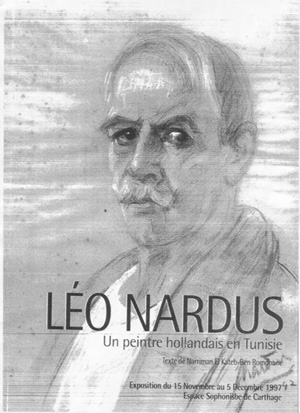
When contacting us by e-mail, correspondents are asked to include their name and full postal address and, when providing information, to quote exact book and magazine sources. The word ‘chess’ needs to appear in the subject-line or in the message itself.
| First column | << previous | Archives [10] | next >> | Current column |
Hans Ree (Amsterdam) has sent us a copy of the biographical sketch in Léo Nardus Un peintre hollandais en Tunisie by Narriman El Kateb-Ben Romdhane, a publication which marked an exhibition of about 50 of Nardus’ paintings at the Espace Sophonisbe in Carthage in November-December 1997.

The narrative states that Léonardus Nardus was born in Utrecht on 5 May 1868, the son of an antique dealer, Emanuel Salomon, and Alida Ballen. After training in art and antiques, he undertook in 1889 a brief, unsuccessful gold-hunting expedition in Argentina. He later became an art dealer, working in the United States as from 1894 but going back to Paris just after the turn of the century. In addition to collecting works of art, he developed his own painting skills. In 1904 he married the daughter of an art-dealer, Hélène Jeanne Marie, and they lived on the outskirts of Paris at the Château d’Arnouville-les-Gonesses and, subsequently, at the Château de Suresnes, which he later named ‘Léa-Flory’, after his two daughters (born in 1905 and 1908). Subsequently Nardus separated from his wife, and the daughters’ upbringing was entrusted to a Bordeaux governess, Marie Gendraud.
He continued collecting works of art and became known, on account of his wealth, as ‘l’homme aux cinquante millions’. In 1911 the Salomon family chose the patronymic name Nardus.
To escape monotony, Léo Nardus travelled extensively, in Italy and Spain (spending a year in Barcelona). He also made trips to Egypt (1900, 1904) and Algeria (1913, 1914 and 1915), but his favourite destination was Tunisia (1899-1900, 1912 and 1913).
His first personal exhibition was at the Galerie Rosenberg, Paris in May 1913. Returning to Holland, he lived from 1915 to 1920 in the village of Blaricum. At the age of 53 (i.e. around 1921) he decided to have a residence (a small palace) constructed in Tunisia, choosing the resort of La Marsa, which is about 20 kilometres from Tunis. He was joined there by his daughters and Marie Gendraud. To avoid the effects of legal proceedings begun by his wife, Nardus entrusted to his friend and associate Arnold van Buuren his collection of 156 paintings, which included works by Rembrandt, Rubens, Hals and Velázquez.
Nardus sustained considerable losses in the 1929 economic crisis but continued to live well in Tunisia and to sponsor local artists. Van Buuren was arrested by the Nazis in 1941, and Nardus’ collection was seized and sold to unknown parties. Van Buuren died in prison during the Second World War, and Nardus was now left only with what he had in Tunisia. His final years were marked by financial difficulties, and in 1951 he was obliged to sell his home in La Marsa to an estate agent in return for a life annuity. He died in June 1955 at the age of 87.
Page 6 of the publication has a photograph of Frank Marshall playing chess against Arnold van Buuren, with Nardus looking on.
Further to our notes on Andrew Bonar Law on pages 207-210 of A Chess Omnibus, we give the following quotation from page 152 of the American Chess Bulletin, July 1912:
‘Speaking against Home Rule, Mr Bonar Law said, among other things: “I don’t know whether any of you play the game of chess. I am rather fond of it myself. If any of you understand anything about it you know it sometimes happens, when two players have been engaged in a game for some time, that one of them announces mate in so many moves and his opponent examines the board, and if he sees the mate is there he surrenders the game. That is the position on the political chess board now. Mr Redmond [John Redmond, the leader of the Irish National Party] has played his game so successfully and, with the Government as sleeping partner, announces mate in three moves. But suddenly the pawns, those vigorous pawns, spring to life, and refuse to be moved by them, and insist on moving themselves, and what becomes of the nice situation then?”’
More particulars about Bonar Law’s speech would be welcomed.
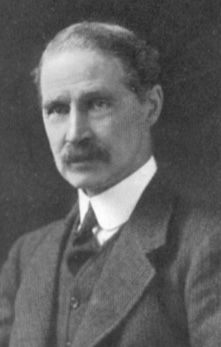
Andrew Bonar Law
The sketch was of Isaac Kashdan. It appeared on page 63 of the September 1937 issue Ely Culbertson’s magazine Games Digest.
Karel Mokrý (Prostějov, Czech Republic) kindly summarizes the
circumstances of Karel Treybal’s death in 1941, on the basis of
1940s Czech sources: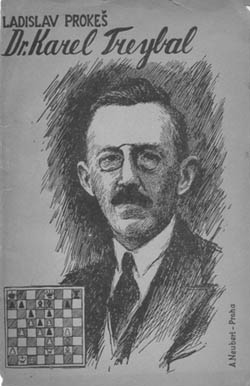
‘As there were no reports on Treybal in the Czech magazine Šach in 1941 or 1942, the most important source is the monograph on him by Ladislav Prokeš, published in Prague in 1946. This states that Treybal, who had been a judge (chairman of the district court in Velvary, a small town in Central Bohemia, north-west of Prague), was condemned to death on 2 October 1941 and executed the same day.
He had been arrested on 30 May in his office at Velvary and was escorted to the Pankrac prison in Prague (which still exists) and from there to prisons in Kladno and Terezin. He was charged with concealment of weapons for use by Germany’s enemies and for having personal possession of a pistol without authorization, although Prokeš gives no indication as to whether or not these charges were true.
He adds that Karel Treybal showed bravery in prison and helped other prisoners. Following his execution, his body was not handed over to his family, and nothing is known about his grave.
A tribute to Treybal by K. Zmatlík appeared on pages 49-50 of the 5-6/1945 issue of Šach, with an English translation on pages 55-56. This stated that Treybal was executed without trial and that he had “never occupied himself with politics”.
An uncommon photograph of Treybal with his family was published on page 71 of the same issue of Šach. The accompanying text said that the ÚJČŠ (Czechoslovak Chess Union) helped the family after his death with an unspecified sum of money.’
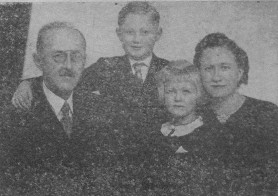
We add that although Treybal’s death was not reported at the time in the Czech magazine, the news spread rapidly. For example, on pages 75-77 of the October 1941 issue of the Argentinian periodical Enroque!! J.A. Seitz wrote a tribute to Treybal, annotating his ‘excellent’ win over Alekhine at Carlsbad, 1923 and relating, on the basis of a report by Reuter, that Treybal had been executed in Prague.
Page 57 of the April 1942 Deutsche Schachzeitung (edited by H. Ranneforth and J. Halumbirek) had an eight-word news item stating that Treybal had ‘died recently’:
‘Der tschechische Meister Karl Treybal ist kürzlich gestorben.’
The fake Alekhine v Capablanca photograph continues to crop up in various guises, and we recently even acquired a mousepad depicting it. As regards the Alekhine part of the picture, the German tobacco card below (which features A. Alekhine, V. Tietz and A. Nimzowitsch) may be noted, not least because C.N. 3513 reported that the board position in the Alekhine v Capablanca photograph was from Nimzowitsch v Alekhine, Semmering, 1926.
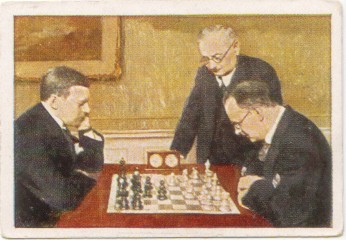
For another copy of the tobacco card, together with a discussion of the complete set, see pages 42-43 of the May 2005 CHESS (an article by Gareth Williams).
C.N. 3100 quoted the statement by Peter Fuller on page 49 of The Champions (New York, 1977) that ‘Steinitz claimed to have played God at pawn odds and won’, and in C.N. 3101 we asked how far back, and in which different forms, the story could be traced. The following small sample was given from the output of some post-Second World War writers:
From page 114 of The World of Chess by A. Saidy and N. Lessing (1974):
‘According to one story, he claimed to be giving God odds of pawn and move.’
In Grandmasters of Chess (e.g. page 113 of the 1973 edition) Harold C. Schonberg affirmed:
‘He also tried to get in touch with God; he wanted to challenge the Deity to a match, offering Him odds of pawn and move.’
From page 42 of The Psychology of the Chess Player (1956/1967) by R. Fine:
‘One story says that he claimed to be in electrical communication with God, and that he could give God pawn and move.’
On page 9 of The Bright Side of Chess (1948) Irving Chernev wrote:
‘Confidence? Steinitz had enough of it to say once that he did not believe even God could give him pawn and move odds.’
The origins of the story remain to be traced, but Avital Pilpel (New York) now writes to us:
‘In his article in Time about Fischer entitled “Did Chess Make Him Crazy?” (http://www.time.com/time/columnist/krauthammer/article/0,9565,1054411,00.html) Charles Krauthammer follows the usual mode of such essays: start with an old anecdote about a master’s bizarre behavior; assume that chess caused this behavior; then speculate that chess causes insanity. In Krauthammer’s view, a “particularly fatal” and “unique” characteristic of chess is that it is “a playing field on which the other guy really is after you”. Imagine that. A board game where both players try to win ...
Krauthammer says that “Steinitz claimed to have played against God, given him an extra pawn and won”. This story has many forms. As C.N. 3101 notes, Fine’s version (in The Psychology of the Chess Player) has “[Steinitz] claimed to be in electrical communication with God, and that he could give God pawn and move”. Telegraphic or electrical communications feature in many versions of the tale. I suggest that what we have here are two unrelated stories that became crammed together.
In Steinitz’s day, the late nineteenth century, many – including leading scientists – speculated that the newly-discovered invisible substance, electricity, might at long last explain the supernatural: perhaps spirits, God, angels, etc. might be proven actually to exist, as electrical entities of some sort. If so, communicating with them by electrical means (such as the telegraph) might be possible.
If Steinitz had ever made similar claims (again, at the time, by no means evidence of mental illness), a later writer might mistakenly believe that both of Steinitz’s unrelated claims – about the possibility of communication with God by telegraph and about his possible result against God – referred to the same incident. He might conclude that Steinitz was speaking (on two different occasions) about the means and the result, respectively, of a game played with God.
But first things first: did Steinitz, in fact, show any interest in the paranormal in general, and in communicating with it by electrical means in particular?’
We shall welcome any relevant quotes, and for now we merely add that a lengthy article ‘Steinitz says he is not mad’ dated 23 March 1897 (our copy of which is in the third of Walter Penn Shipley’s scrapbooks – see page 45 of Chess Explorations) included the following:
‘He thought he could succeed in telephoning without any apparatus at all by mere force of will, and so he stood in the middle of a room and talked and sang loudly with the wish that such and such persons should hear him; and by degrees he imagined that he got answers, that those he addressed sang the chorus to his songs.’
For a slightly different wording see page 345 of William Steinitz, Chess Champion by K. Landsberger (Jefferson, 1993).
For a book in preparation Alberto Fabris (Conegliano, Italy) is seeking daily bulletins of the following women’s olympiads: Emmen, 1957; Split, 1963; Oberhausen, 1966; Lublin, 1969; Skopje, 1972; Medellín, 1974. In the absence of bulletins, he wishes to obtain as many games as possible from these events and to establish the round-by-round schedules. Any information readers are able to provide will be passed on to our correspondent.
Jerry Spinrad (Nashville, TN, USA) draws our attention to the following paragraph on page 6 of the New York Times, 3 October 1941 under the title ‘Shooting Them by Carloads’ with the dateline ‘Berlin Oct. 2 (UP)’:
‘Those executed today were said to include Josef Benes, manager of the Farmers’ Association at Raudnitz; Anton Kvarda, manager of the trades school at Rakonitz; Karel Treybal, salesman; Josef Smrkovsky, business man, and Manzel Svoboda, former Czech Army lieutenant.’
As noted in C.N. 3729, Karel Treybal was, in fact, a judge.
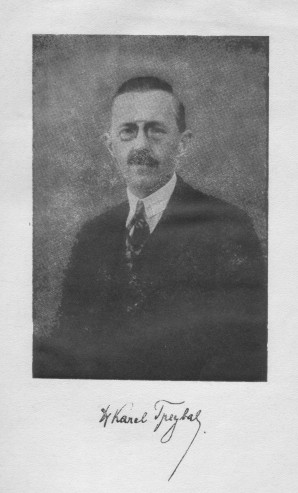
From José Fernando Blanco (Madrid):
‘I have been browsing through the book Mitología del Ajedrez by Francesc Lluís Cardona (Barcelona, 2000). This Doctor of History declines to apply rigorous standards of accuracy and research, adopting instead a casual approach which is more usual in chess history.’
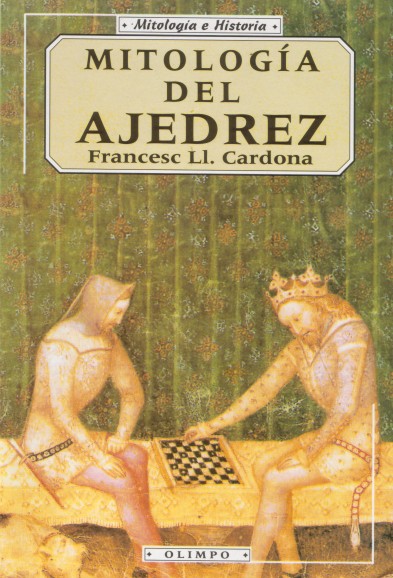 Our correspondent is
certainly right, and all the examples below come from the
three-page section on world championship matches (pages 83-85).
Our correspondent is
certainly right, and all the examples below come from the
three-page section on world championship matches (pages 83-85).
For a book to state that Petrosian lost his title to Spassky in 1968, rather than 1969, may be regarded as a minor mishap, even when it mishappens twice, and that is certainly small beer for F.Ll. Cardona, whom the back cover describes as ‘Doctor y Catedrático de Historia’. After all, he also says that the world championship tenure of Anderssen (‘Andersen’) lasted from 1862 all the way through to 1966, while the 1908 Lasker v Tarrasch match is dated 1090.
Even when the author is not out by a century or eight, the
results listed contain every kind of error. All the games in
Steinitz’s matches against Anderssen in 1866 and Blackburne in
1876 were decisive, but from thin air the author’s list conjures
up 6 draws and 4 draws respectively. The final scores of the 1929
and 1934 matches between Alekhine and Bogoljubow are inverted,
while Alekhine’s result against Euwe in 1937 is given as +1 =13
-6, which is Dr Cardona’s stab at reporting +10 =11 -4. The number
of contenders in the 1948 match-tournament is increased from five
to eight, without anyone other than Botvinnik being named. In best
Cardona (and Cardoza) style the book also indicates that Bronstein
won the world championship in 1951, by attributing to him 6
victories, instead of 5, against Botvinnik. Later on (i.e. after
the Spassky v Fischer match in ‘Reiviavik’) the list capriciously
switches from giving wins, draws and losses to stipulating only
the final points scored, but that does not prevent the author from
going astray with the third Kasparov v Karpov match (where he puts
12-11 instead of 12½-11½). By his customary standards, however,
that is tantamount to being spot on.
Whereas the label ‘world championship’ is attached to Steinitz’s matches against Anderssen (1866), Blackburne (1870 and 1876) and Zukertort (1872), as well as to Lasker v Janowsky, Paris, 1909, several matches are left unmentioned which really were for the world title (Petrosian v Spassky, 1966; Karpov v Korchnoi, 1978; Karpov v Korchnoi, 1981; Karpov v Kasparov, 1984-85; Kasparov v Karpov, 1990). Thus Korchnoi’s name is nowhere to be found, and the last mention of Kasparov relates to 1987, apart from a freak lapse (see below) when Dr Cardona calls Karpov ‘Kasparov’.
Matches held at various venues are simplified to a single city: Steinitz v Zukertort, New York, 1886 (although our crass chronicler puts ‘1888’); Lasker v Steinitz, New York, 1894; Lasker v Marshall, New York, 1907; Lasker v Schlechter, Vienna, 1910; Alekhine v Bogoljubow, Berlin, 1934; Alekhine v Euwe, Amsterdam, 1935; Euwe v Alekhine, Rotterdam, 1937. German cities are particularly bothersome for the Doctor of History. The 1929 match between Alekhine and Bogoljubow is listed as played in ‘Munich’, where no games took place. Similarly, the ‘1090’ Lasker v Tarrasch match was played in Düsseldorf and Munich, not ‘Berlin’. On the other hand, the 1910 match between Lasker and Janowsky was held in Berlin, and not ‘Paris’.
It is regarding Karpov v Timman (‘1993 Amsterdam-Yakarta’) that Karpov is called ‘Kasparov’. Timman becomes ‘Tumman’. The three pages under consideration also feature references to ‘Aleskhine’, ‘Blackurne’, ‘Janosvsky’, ‘Pretrosian’, ‘Stauton’ and ‘Zuckertort’.
Andy Ansel (Walnut Creek, CA, USA) adds to the mystery:
‘Regarding the game between Pope Leo XIII (as Cardinal Pecci) and Rev. Fr Guila here is a quote from pages 4-5 of the January 1944 South African Chess Magazine, where the game is given:
“Papal Chess – on the occasion of the death of Pope Leo XIII in 1903, the following reference was made to him by the Chess Editor of the Times: ‘It was well known that the late Pope Leo XIII made a recreation of chess for very many years. It is said that a favourite opponent of his holiness, Father Guila, would sometimes take the game so seriously as to bring upon himself a mild rebuke from the Pope and a little homily upon the necessity for Christian resignation and self-control.’ (Times Weekly Edition, 7 August 1903).”
Here is a game played between these opponents some three years before Cardinal Pecci was elected to the Papacy in 1878 ...”’
Page 102 of the September-October 1937 American Chess Bulletin transcribed a radio broadcast (Station WYNC, New York City) by Hermann Helms. A brief extract is given below:
‘The courage of the man is downright amazing, so I was moved to ask: “Doctor, do you ever intend to retire?”
To which he replied with a smile: “No; at any rate not until I have succeeded in gaining a competence from chess.”
He gave me a wink, as he said it, for you must know that the pursuit of chess professionally is not exactly a producer of wealth in large figures.’
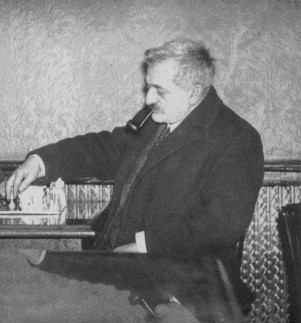
Emanuel Lasker
Which chessplayer is being described below?
From Michael Clapham (Ipswich, England):
‘Your pamphlet A Brief Review of the Chess Record of José Raúl Capablanca by Dana Welles, mentioned in C.N. 3674, is not recorded in Douglas A. Betts’ book An Annotated Bibliography of Works Published in the English Language 1850-1968 (Boston, 1974). Here are four more which escaped Betts’ notice:
1. Chess Made Clear by Rev. H.C. De Barathy, M.A. Date and publisher not known but printed by The Kent County Press. Possibly 1930s or 1940s.
This is a very basic primer of 29 pages. From the Preface: “The object of this book is to make the explanation of the game as simple as possible and to assume from the very start that the beginner has no idea of the shapes, names or movements of the chessmen.”
2. Drueke’s Chess Primer. No author noted but published by Wm. F. Drueke & Sons, Inc. Grand Rapids, Michigan. No date, but the laws of chess are from 1931. 30 pages plus two pages of advertisements.
Another very basic primer covering the rules, notation, nine openings and one illustrative game, Morphy v the Duke and Count.
3. The Symbolism of Chess and Cards by W.B. Crow, published by Michael Houghton, London, 1944, 38 pages.
The section on chess deals mainly with the history and variants of the game, and much of the information comes from Chess Eccentricities by Major G.H. Verney, London, Longmans, Green, 1885.
4. The Pocket Chess Problem Recorder published by Thos. De La Rue & Co. Ltd. London, 1899.
This book contains pages of empty chess boards and a supply of adhesive chess pieces perforated as on a sheet of stamps. The pieces are detached and placed on the chess board to record problems, endings or positions.
Perhaps further omissions from Betts could be catalogued by your readers.’
Our collection contains two other editions of Drueke’s Chess Primer (although they have, for practical purposes, identical texts), as well as, from the same publisher, A Beginners Book of Chess (1917).
And, above all, there is Chess & Draughts Made Easy by J. Bishop (see page 366 of A Chess Omnibus). Never have we found a mention of that book, which was published in London around 1860, in any bibliography or catalogue.
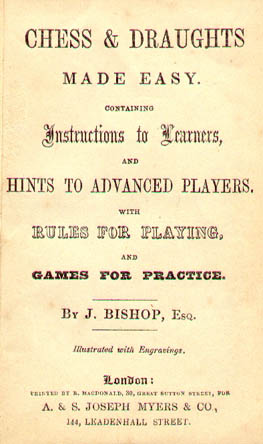
Whether J. Bishop was a pseudonym is unknown, but as a long shot it may be noted that in 1898 (15 April issue, pages 104-106, and 15 June issue, pages 171-172) La Stratégie published two games lost by a player named J. Bishop, of Iquique (Chile).
Readers are welcome to point out any interesting omissions from Betts’ Bibliography but, to keep matters in perspective, we would classify it as one of the most accurate and useful chess reference works ever published.
At Bournemouth, 1939 Gerald Abrahams finished last with a single point, derived from a long win (available in various databases) against Mieses in the second round. CHESS, October 1939 (page 3) reported that during the game Mieses refused a draw five times. Do readers know of comparable cases of multiple refusals?
On the subject of Mieses, the following comes from an article entitled ‘Psychology and the Art of Chess’ which he contributed to Contemporary Review and had reprinted in CHESS, April 1940, pages 154-156:
‘I consider it very questionable indeed that chess talent implies any gift, even in minor proportions, for other fields of mental activity; or that aptitude for chess enriches the mind universally. In this connection I should like to warn young people, at all events those yet at their studies, against any too intensive occupation with the game. It is true that chess is one of the noblest of mental recreations, a real “stamping ground” of cleverness; but it contains a world all its own, an abstract world of strange charm. Whoever has once experienced this fascination may easily succumb to it and thereby develop one-sidedly; particularly since chess, as fundamentally a game of combat, lends powerful impetus to one’s ambition to improve in it. It is precisely the talented youngster who is most exposed to this danger. Only he who has attained a certain degree of completion to his general education and spiritual development and whose character has passed the moulding stage may devote himself freely to the goddess of chess without fear of the consequences. The noble game has its depths, in which many a fine and gentle soul, alas, has vanished.’
Page 67 of Modern Chess Analysis by Robin Smith (London, 2004) ascribes the following quote to Capablanca:
‘Chess books should be used as we use glasses: to assist the sight, although some players make use of them as if they thought they conferred sight.’
As indicated in C.N.s 325 and 3160, we believe this to be an old misattribution resulting from the lay-out of pages 112-113 of The Bright Side of Chess by Irving Chernev (Philadelphia, 1948):
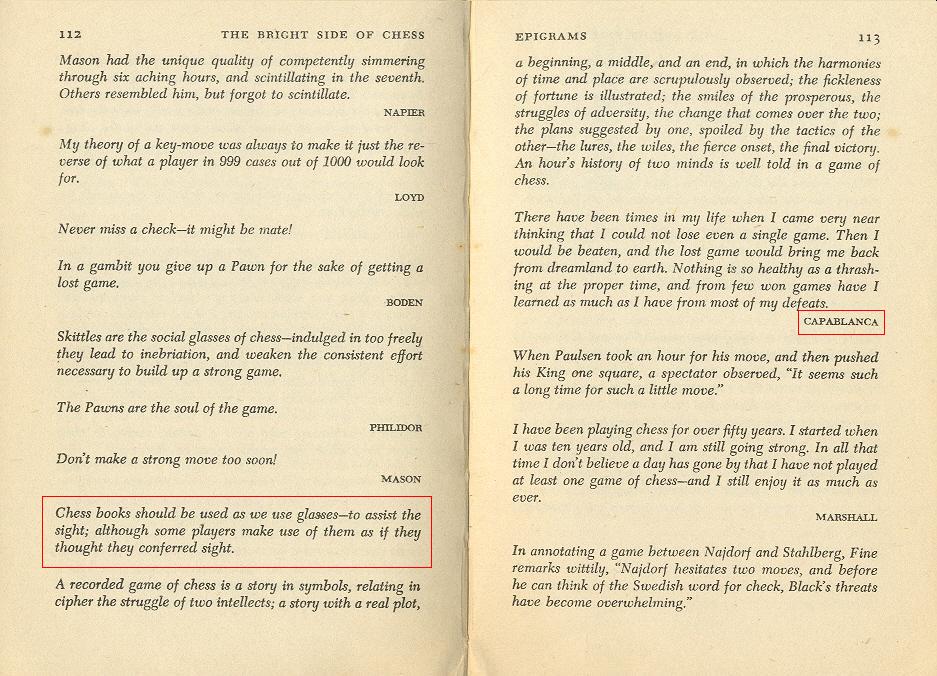
The intermediate quote beginning ‘A recorded game ...’ is also at variance with Capablanca’s prose style, and it would hardly be logical to regard Philidor as the originator of the skittles quote or Marshall as the writer of the Paulsen anecdote. But can readers help us put this matter beyond all doubt? Certainly we have no recollection of the glasses quote in any of the Cuban’s writings, but had it appeared in print before Chernev’s book was published (in, for instance, an article by Chernev)? And who first conferred the quote upon Capablanca? As regards that last question, the earliest instance known to us is page 85 of Championship Chess and Checkers For All by Larry Evans and Tom Wiswell (New York, 1953).
From page 25 of the American Chess Bulletin, February 1909:
‘Wanted
A youth with the genius of Morphy, the memory of Pillsbury and the determination of Steinitz; of robust health which he values above rubies; full of a modest joy of living and possessor of habits of life that square with a sensible ideal – as adversary for the present and invincible champion of the world.
Unto such an [sic] one will come support unlimited, friends by the legion, imperishable glory and, possibly, Victory!’
Irving Chernev wrote on page 45 of Curious Chess Facts (New York, 1937):
‘In its issue of February 1909, the American Chess Bulletin carried this appeal: “Wanted – a youth with the genius of Morphy, the memory of Pillsbury, the determination of Steinitz, etc.”
They received a quick reply to this advertisement (the terms of which seemed so difficult) when their own pages recorded, a few months later, the decisive victory of Capablanca, the new chess star, in a match with Marshall.’
Page 51 of the May-June 1937 American Chess Bulletin commented:
‘... Curious Chess Facts misses the point. The underlying thought of that passage, written in the heyday of Dr Lasker’s phenomenal career, was the utter impossibility of anyone, except a superman, winning from him. It was the best we could do at that time in the way of a compliment to tremendous prowess.’
It may, though, be wondered to what extent Chernev really missed the point; certainly he made similar use of the 1909 Bulletin item on pages 37-38 of Wonders and Curiosities of Chess (New York, 1974), as did Fred Reinfeld in the first paragraph of his biography of the Cuban on page 1 of The Immortal Games of Capablanca (New York, 1942).
In contrast, an author who definitely missed the point was Mario Leoncini, on page 43 of Aneddoti di scacchi (Brescia, 2003). After quoting from the Bulletin ‘advertisement’ he bafflingly concluded, ‘It was very difficult to satisfy all the conditions, but many replies came in’. (‘Era molto difficile soddisfare tutte le condizioni ma arrivarono molte risposte.’ )
This rare illustration of Capablanca, ‘the young Cuban chess wonder’, is taken from The Topeka Daily State Journal of 7 December 1909:
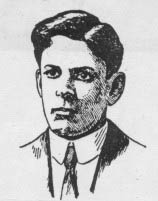
C.N. 3249 gave the following game from page 146 of Social Chess by James Mason (London, 1900), which had the bare heading ‘won by R.J. Buckley’:
1 e4 e5 2 Nc3 Nc6 3 f4 exf4 4 Nf3 g5 5 h4 g4 6 Ng5 h5 7 d4 f6 8 Bxf4 fxg5 9 Bxg5 Be7 10 Nd5 Bxg5 11 hxg5 Nge7 12 Nf6+ Kf8 13 d5 Ne5 14 d6 cxd6 15 Qxd6 Nc6 16 Nd5 Rh7 17 Bc4 Na5 18 O-O+ Kg8 19 Nxe7+ Kh8 20 Qf6+ Rg7 21 Qh6+ Rh7 22 Ng6 mate.
Now Alan Smith (Manchester, England) reports that Buckley published the game in the Manchester City News of 30 May 1908, where he specified that it was played at Simpson’s Divan in London ‘sometime in the 1880s’ in a match against an Austrian player named Ott which Buckley won 6-0.
Alan Smith also submits this game:
William Albert Fairhurst – Arthur John Mackenzie1 e4 c6 2 d4 d5 3 exd5 cxd5 4 c3 Nf6 5 Nf3 Nc6 6 Ne5 Bf5 7 Bf4 Qb6 8 Qb3 Qxb3 9 axb3 Bxb1 10 Rxb1 Nxe5 11 Bxe5 Nd7 12 Bg3 e6 13 Ra1 Be7 14 Bb5 a6 15 Kd2 O-O-O
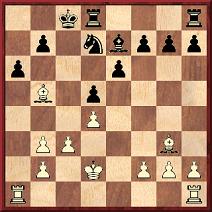
16 Rxa6 Nb8 17 Rb6 Rdg8 18 Ra1 Bd8 19 Ra8 Bc7
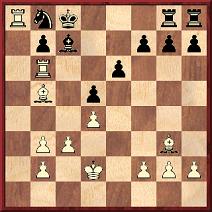
20 Bd7+ Kxd7 21 Rxb7 Rc8 22 Raa7 Ke7 23 Bxc7 Nc6 24 Ra6 Resigns.
Source: Manchester Guardian, 31 January 1927.
C.N. 3397 discussed a sketch of Howard Staunton by Sam Loyd, published by the latter in his column on page 1470 of the Scientific American Supplement, 6 October 1877:
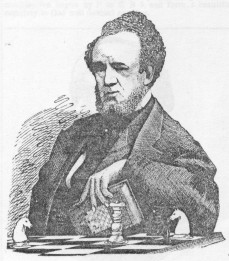
We have now found the picture on which it was evidently based:
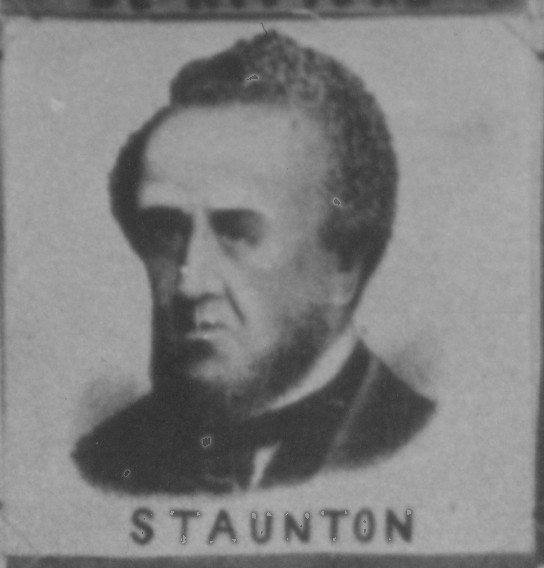
This comes from a 6x6 composite photograph of chess figures which we have recently acquired:
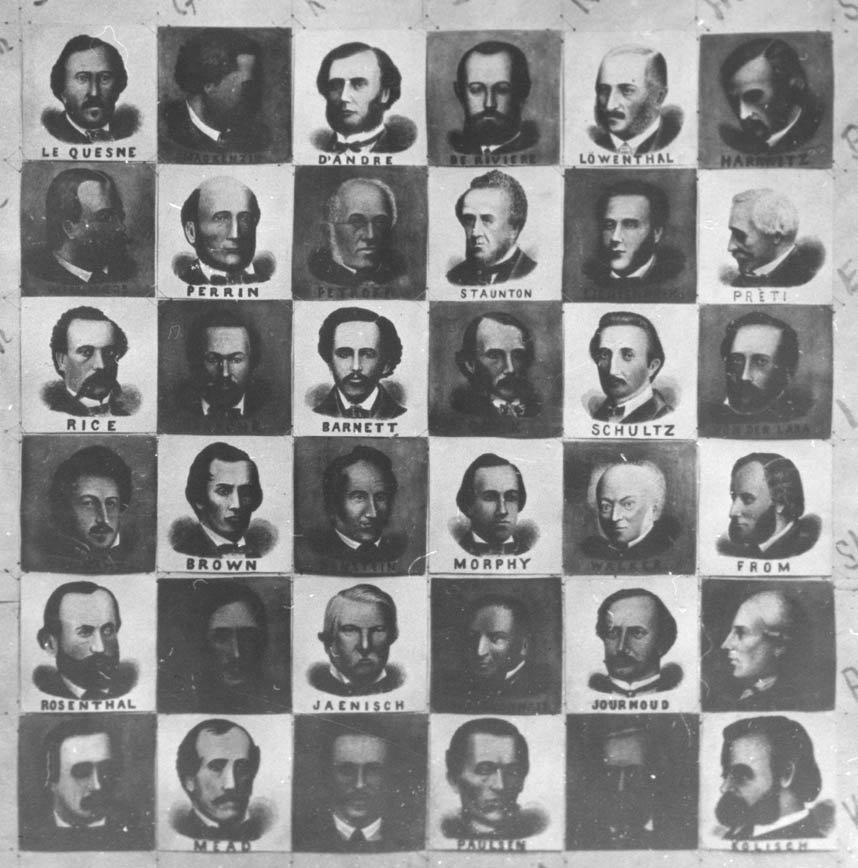
A larger version can be viewed by clicking here.
Can a better-quality copy of the Staunton picture, and some of the others, be found?
From Calle Erlandsson (Lund, Sweden):
‘In 1965 Bent Larsen lost his Candidates’ match in Bled against Tal 4½-5½. In his report on page 129 of the 9/1965 issue of Skakbladet he wrote:
“But if I could conclude with a prediction: the world champion in 1972 will have a name beginning with S, T or L.”’
We asked which chessplayer was being described by the following:
The answer is Grace Alekhine, the world champion’s last wife. Her obituary on pages 99-100 of the April 1956 BCM reported that she was American-born and married Alekhine at Villefranche-sur-Mer in 1935, at which time she was the widow of a British tea-planter in Ceylon. She retained her British nationality to the end of her life. ‘The last few years she had spent partly in her studio in the French capital, and partly at St Ives, Cornwall, where she was a member of the local chess club.’
It was on page 11 of the October 1947 issue of CHESS that she wrote, from Dieppe, about chess notation:
‘I sincerely hope Mr Wood will not continue with his combination notation as I find it extremely unpleasant. I am thoroughly familiar with the algebraic notation and enjoy games in French, Spanish, German or Czech so it is not on that account that I object to his innovation. If he continues with it, I shall not renew my subscription again.’
Below is an example (from page 337 of the August 1947 CHESS) of the notation occasionally used at that time:
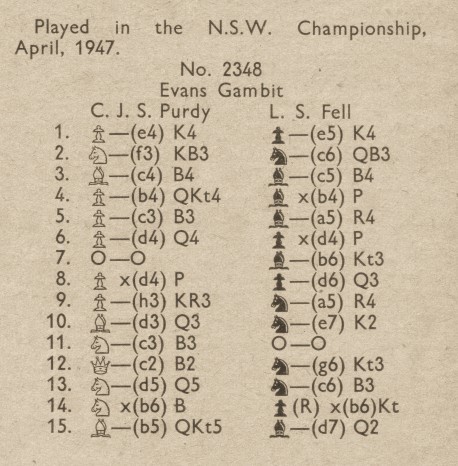
Page 54 of the February 1937 BCM reported that ‘Madame Alekhine (France)’ had won third prize in the ‘Third Class (morning)’ tournament at Hastings. She won £1, while her husband received £15 for finishing top in the Premier Tourney.
The photograph below, taken later that year, comes from page 277 of the Kemeri, 1937 tournament book (published in Riga in 1938):
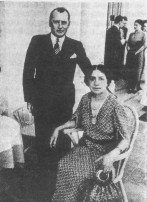
C.N. 1728 (see pages 134-135 of Chess Explorations) quoted a statement by CHESS on page 34 of its December 1941 issue that at Kemeri, 1937 Franz Apscheneek (Fricis Apšenieks) took only about 15 minutes on his 33-move draw against Alekhine, whereas the latter consumed over two hours. In C.N. 1760 the late Karlis Ozols informed us:
‘Fritz Apšenieks was a brilliant chess tactician. He played very fast, but in complicated positions was always able to find the right move. I could not confirm or deny the story concerning his game in Kemeri with Alekhine.’
Further particulars about Apscheneek’s speed, at Kemeri and elsewhere, have yet to be found.
Below is a group photograph from Kemeri, 1937:
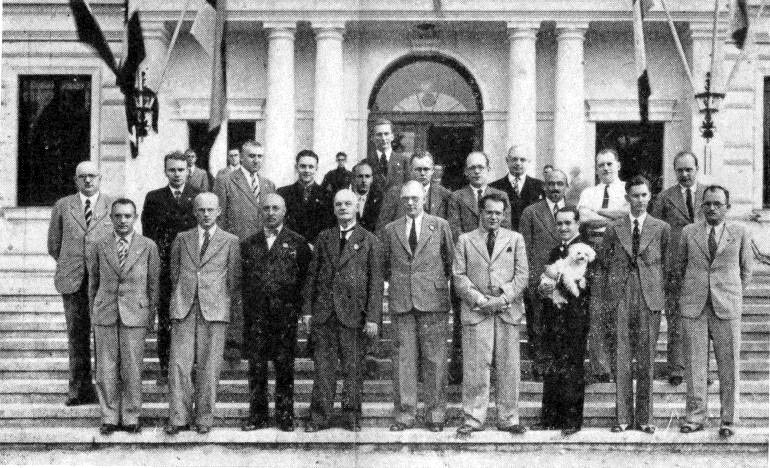
Front row from left to
right: V. Petrovs, F. Apscheneek, A. Melnbārdis, K.
Bētiņš, H. Kmoch, S. Landau, S. Flohr, P. Keres, E.
Steiner.
Behind: J. Kalniņš, E. Giese, P. Ķeirans, V. Mikenas, M.
Feigins, K. Ozols, L. Rellstab, E. Böök, S. Tartakower, A.
Kanenbergs, A. Alekhine, G. Ståhlberg
The CHESS item noted that ‘Apshenayek’ had died (earlier that year) of pulmonary phthisis, at the age of 47. ‘He was an eccentric, and looked it, but a very kind-hearted man.’
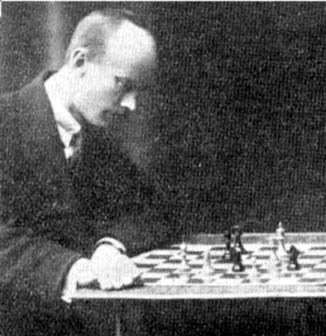
Franz Apscheneek (Fricis Apšenieks)
As a forgotten specimen of his play, we take a score from pages 166-167 of Šachs Latvijā by K. Bētiņš, A. Kalniņš and V. Petrovs (Riga, 1940):
Dezső Szabó – Franz Apscheneek (Fricis Apšenieks)1 d4 d5 2 Nf3 c6 3 e3 Bf5 4 Bd3 e6 5 c4 Bb4+ 6 Nc3 Nf6 7 cxd5 Bxd3 8 Qxd3 exd5 9 a3 Be7 10 O-O Nbd7 11 e4 dxe4 12 Nxe4 O-O 13 b4 Re8 14 Nxf6+ Bxf6 15 Be3 Nb6 16 Bf4 Nd5 17 Be5 Nc7 18 Qc4 a6 19 Rad1 Nd5 20 Rfe1 Be7 21 Rd3 Qd7 22 Rb1 b5 23 Qc1 a5 24 bxa5 Rxa5 25 Bg3 f6 26 Ne1 Rea8 27 Nc2 Qf5 28 Rdb3 Ra4 29 Nb4 Rxa3 30 Nxc6 Bf8 31 Rxb5 Kh8 32 Rb8 h5 33 Rxa8 Rxa8 34 Rb8
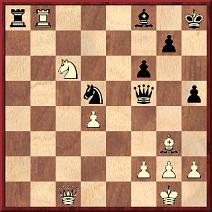
34...Nc3 35 Qxc3 Rxb8 36 h4 Rc8 37 Qc4 Qe4 38 Qf7 Qxc6 39 White resigns.
Jerry Spinrad (Nashville, TN, USA) draws attention to accounts in the New York Times of 21 May 1897 (page 4) and 14 August 1900 (page 5). In the first the newspaper reported that while Steinitz was in Russia ...
‘... someone presented him with a mechanical contrivance that looked like a silver snuffbox, and told him that it was a new invention in telephoning. If anyone spoke into a hole in the box the sound, he was told, would be transmitted to a wire, and could be heard at any distance.
This box, Mr Steinitz said, he took to his rooms and began experimenting, imagining that he had a wonderful invention which would bring him a fortune. His secretary told him his son in America could hear him. He was not feeling well at the time; his nerves were unstrung by his hard work at chess, and the statement of his secretary made him still more nervous. Later he was taken to an asylum on the representations of his secretary.
Mr Steinitz said he had made no definite plans for the future. He wants to rest and to see if he can get any redress for being sent to the asylum.’
The second item, the obituary of Steinitz, included the following:
‘... he would experiment with his wireless telephone. His theory was that he could use his willpower to convey words any distance. For hours he would stand in his room trying to “call up” various people he knew in Europe.
After he was tired of these experiments he would devote his time to writing his books.’
For further details (including the full text of the obituary) see pages 356 and 393-396 of William Steinitz, Chess Champion by K. Landsberger (Jefferson, 1993). The first reference to God in this connection is still being sought.
C.N. 3325 gave a series of quotes illustrating various contemporary writers’ views on when Steinitz became world champion. The clearest statement we have seen from Steinitz himself was quoted in his 14 August 1900 obituary in the New York Times, from a pamphlet entitled My advertisement to anti-Semites in Vienna and Elsewhere:
‘And since 1895 I have been obliged at an advanced age and while I was half crippled to export myself in order to import only a portion of my living for myself and family, and this portion did not amount to $250 per annum within the last two years when I deduct traveling expenses and increased cost for staying abroad, although I was chess champion of the world for 28 years!!!’
We also now add a paragraph from page 50 of the Chess Player’s Chronicle, 18 July 1883, i.e. shortly after Zukertort won the London, 1883 tournament, three points ahead of Steinitz:
‘The chess championship of the world is a subject which will form a topic of discussion in the chess press for some time to come. The last issue of the Bradford Observer contains some remarks on it. The writer argues that Zukertort may hold the title and yet be “quite right in refusing to enter into so hard an engagement” (the match recently proposed is referred to) “after the trial he had to go through in the International”. We disagree. It is very certain that Steinitz was, at one time, fairly entitled to the position of champion, and under such circumstances would hold it so long as he could defend himself against all comers. He has just taken an inferior place to Zukertort, in a tournament, and for the time being Zukertort, in the opinion of some, becomes champion, but if he desires to hold that title he must defend himself against all comers; so soon as he declines to play a match, unless under very exceptional circumstances, he loses his position, and this is more particularly the case when his would-be opponent happens to be the man who for years past has been recognized as the champion. A tournamental advantage is not considered of much moment as regards the chess championship, and unless it can be maintained by after play we should be inclined to dismiss it as one of the freaks of fortune. Steinitz has challenged the only man who has beaten him since he has been chess champion; if he will not play, then Steinitz will be right in resuming his old title.’
A noteworthy point is that the item made no mention of Morphy, who was still alive.
C.N. 702 (see pages 184-185 of Chess Explorations) referred to a report on page 26 of the January 1903 BCM that after a game of living chess between Pillsbury and H.L. Bowles in London on 29 November 1902 ...
‘... the proceedings closed with the setting-up of a two-move problem specially composed by Mr H.N. Pillsbury, and ten minutes were allowed to the audience to find the solution, it being announced that the author of the first correct solution opened would be awarded a pocket chess board as a prize, and the fortunate winner proved to be a young son of Mr Gunsberg, the chess master.’
We asked for further information on the problem and on Gunsberg’s son, but without result.
In 1996 Jacques N. Pope brought out Harry Nelson Pillsbury American Chess Champion, page 252 of which gave three problems by Pillsbury, i.e. a couple of three-movers (one composed jointly with G. Reichhelm) and the following two-mover:
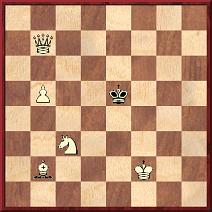
The source of this composition was specified as the Times Literary Supplement, 18 December 1903, i.e. a year after the above-mentioned London event. Was it nonetheless the problem successfully solved by Gunsberg Junior?
Michael McDowell (Westcliff-on-sea, England) sends us a fourth Pillsbury problem, from Womanhood, August 1900 (where it was marked ‘original’):
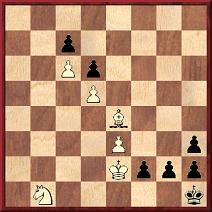
Mate in seven.
As regards Pillsbury’s solving skills, the following item by G. Koltanowski on page 83 of the December 1969 Chess Digest Magazine comes to mind:
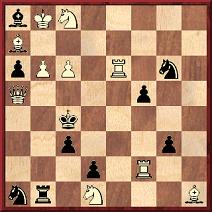
‘White to play and mate in three moves. The author of the problem wrote “... a horrible looking think [sic], which was set up to be difficult and not elegant ...” It was shown to the Masters participating at the New York International Tournament of 1893. It took Dr E. Lasker, champion of the World at that time, 35 minutes to solve. Pillsbury took 40 minutes. The others were way off.’
Quickly passing over Koltanowski’s customary inaccuracy (in 1893 Lasker was not world champion), we note that he did not name the composer. As Michael McDowell mentions to us, the problem is number 247 in A.C. White’s Sam Loyd and His Chess Problems (Leeds, 1913). Pages 200-201 identify it with the caption ‘Manhattan Chess Club, 1893’ and quote Loyd:
‘No. 247 is a horrible looking affair designed for a State Solving Contest. It was evidently posed for difficulty and not for elegance.’
What was the source of Koltanowski’s assertion about the (surprisingly long) time taken by Lasker and Pillsbury to solve the problem?
We have it on the authority of Raymond Keene that after the fourth game of the 2004 Kramnik v Leko match in Brissago Peter Leko declared:
‘My cousin Sammy told me a true slugger – a Szeged slugger – will always swing for the fences, and that is exactly what I am going to do. I am going to knock Kramnik out of the room with my “home run punch”. My trainer and I have been developing it in camp. I just hope Vladimir’s head is screwed on tight or it may end up on top of the demonstration board!’
After quoting these words, on page 114 of his book World Chess Championship Kramnik vs. Leko, Mr Keene reported:
‘Kramnik made a face – and a fist – but chose to reserve a fuller reply for the chessboard.’
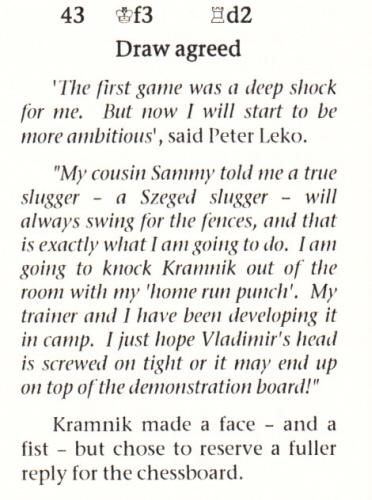
But did Leko, a gentleman, speak any of those words attributed to him by Mr Keene? Drawing this matter to our attention, Alan O’Brien (Mitcham, England) writes:
‘It struck me that this mix of boxing and baseball terminology sounded unusual coming from a Hungarian, so I decided to trace the source of the quote. The first time I have found it mentioned is at http://www.chessgames.com/perl/chessgame?gid=1306947&kpage=59. In a posting dated 3 October 2004 somebody using the pseudonym “Offramp” asserted that the words quoted above (completed with “I will knock Kramnik senseless. He is going down in game five. And he is going down HARD!”) had been spoken by Leko during a press conference after game 4.
Incidentally, Raymond Keene mentions the www.chessgames.com site many times in his book on the match, but not in this case.
I was curious as to where “Offramp” had obtained the quote, and at the webpage http://www.eastsideboxing.com/news/sternburg2210.php I found the following text:
“Sosa: ‘I'm Going to Knock Manfredy Out of the Park!’
… Dominican national lightweight champion Victoriano Sosa predicted a ‘home run-style’ knockout against former WBU champion Angel Manfredy when they rumble, Saturday, 9 November, on the pay-per-view extravaganza ‘Real Fights!’ …
Sosa, the cousin of Chicago Cub home run king Sammy Sosa, spoke today from his training camp outside Chicago …
‘My cousin Sammy told me a true slugger – a Sosa slugger – will always swing for the fences’, said Sosa. ‘And that is exactly what I am going to do. I am going to knock Angel out of the ring with my “home run punch”. My trainer and I have been developing it in camp. I just hope Manfredy’s head is screwed on tight or it may end up in the bleachers!’ …
‘I will knock Manfredy senseless. He is going down in five. And he is going down HARD!’”’
Yet another memorable episode …
From pages 8-9 of Blackmar-Diemer Gambit edited by K. Smith and J. Jacobs (Chess Digest, Dallas, 1977):
‘Blackmar himself seems the epitome of the Southern gentleman: Born on 30 May 1826 in Bennington, Vermont, he later moved to Jackson, Louisiana, where by 1845 he was a Professor of Music at Centenary College. In 1856, Blackmar opened the first piano and music store in Jackson, Mississippi. Four years later, in 1860, he founded together with his brother a music publishing house in New Orleans. There, Blackmar arranged and/or published a number of famous songs of the Confederacy, among them The Bonnie Blue Flag, The Dixie War Song and The Southern Marseillaise. One of his own compositions later became a part of the musical score to the Clark Gable-Vivien Leigh film version of Gone with the Wind. Blackmar was also an able, enthusiastic chessplayer and a charter member of the Chess, Checker and Whist Club of New Orleans.’
In C.N. 2063 (see pages 153-154 of Kings, Commoners and Knaves) Gary Lane, who was writing his own monograph on the Blackmar-Diemer Gambit, asked whether the claim about Gone with the Wind was true. As indicated in C.N. 2119, we could provide no details, even after contacting the Chess Digest editor, Ken Smith. In reply to our enquiry about the source of the information in his 1977 book Mr Smith replied, ‘Don’t remember’, ‘All information I had was given’ and, even more disconcertingly, ‘I don’t know what book this is. Anyway I have no copy’.
Can readers supply any solid information? All we can add for now is that our collection contains two (undated) musical scores: Gavotte Moderne (published by Blackmar & Co., 647 Market St., San Francisco) and The Songs and Ballads of Mlle Parepa (published by A.E. Blackmar, 167 Canal Street, New Orleans):
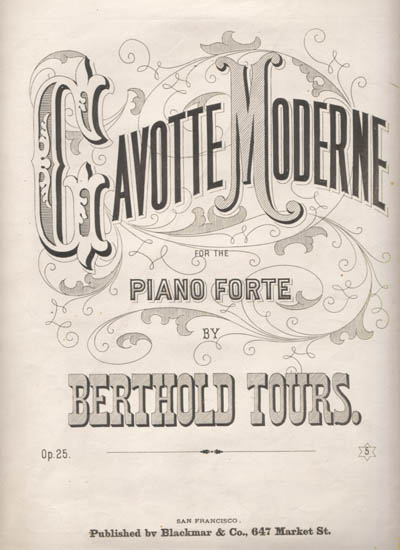
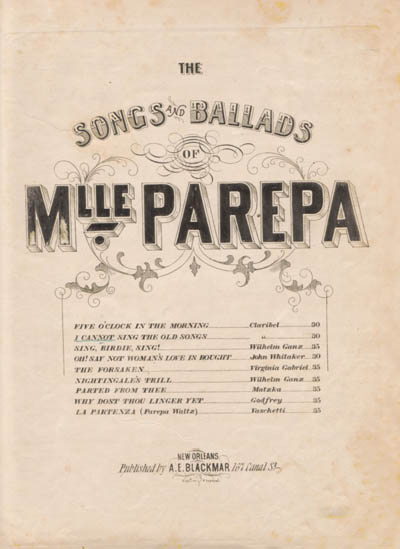
From Paul Timson (Whalley, England):
Peter Nicholas Lee – David J. Mabbs‘It was good to see my old team-mate David Mabbs mentioned in C.N. 3648 in the same breath as Gary Kasparov.
It remains to be seen whether Kasparov’s retirement will last longer than Mabbs’s. Certainly despite the lack of tempting offers Mabbs was back playing chess by early 1969. Page 2 of issue 28 of the Middlesex Chessletter records him as playing on Board 15 for Middlesex against Surrey on 18 January 1969, and he played in the Middlesex Championship the following year. He was a very fine amateur player, having been the British under-18 champion in 1958, and was the co-founder of the Cedars Chess Club (see the article on pages 44-45 of the June 2002 CHESS).
The following game is a good example of Mabbs’s style and features a very unusual attack for Black in the Ruy López, against an opponent who won the British Championship the following year. The score and notes are taken from page 3 of the Middlesex Chessletter of June 1964, which commented:
“It is always remarkable to us how many games David Mabbs draws. His style is a compound of arson, mayhem and felo de se. Anyway, here is one he doesn’t draw. A straight case of annihilation.”’
1 e4 e5 2 Nf3 Nc6 3 Bb5 a6 4 Ba4 Nf6 5 O-O Be7 6 Re1 b5 7 Bb3 d6 8 c3 Na5 9 Bc2 c5 10 h3 Qc7 11 d4 Nc6 12 Nbd2 g5 (‘Here we go.’) 13 a4 Rb8 14 dxc5 dxc5 15 Nf1 g4 16 hxg4 Bxg4 17 Ne3 Rg8 18 axb5 axb5 19 Qe2 Qc8 20 Nd5 Nh5 21 Qe3 (‘Somewhere about here White was busy writing a suicide note; however, there are less painful deaths than waiting for D.J.M. to attack.’) 21...Bh3 22 Nxe7 Rxg2+ 23 Kf1 Qg4 (‘Threatening mate by 24….Rxf2+ and by ...Ng3+.’) 24 Ke2
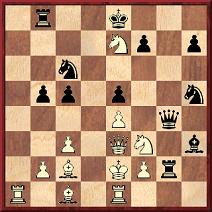
24...Nd4+ 25 cxd4 exd4 26 Qh6 Rxf2+ 27 Kd3 Qxf3+ 28 Be3 Bf1+ 29 Rxf1 Qe2 mate.
Below is the front cover of the May 1943 Chess Review, but what is known about K. Nadzhmetdinov?
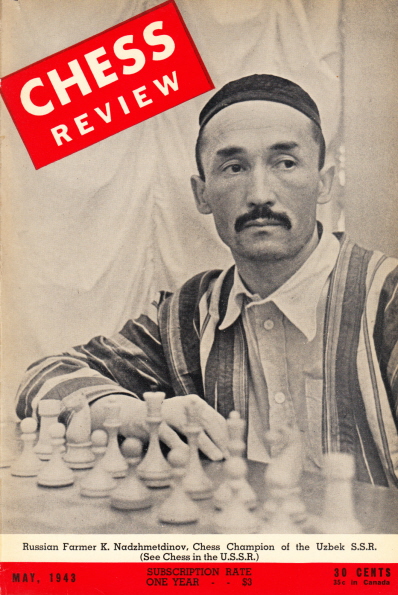
The only information provided inside is on page 147:
‘In 1939, tournaments were held by the collective farm members of the different Republics and the winners played in the All-Union Collective Farmers’ Chess and Checkers Tournament. Among those who came to Leningrad for this event was farmer K. Nadzhmetdinov, chess champion of the Uzbek SSR.’
C.N. 1105 (see pages 110-111 of Chess Explorations) quoted a report on the 1916 court case in which Charles Jaffe sued Hartwig Cassel. We now add the account published on pages 183-184 of the scarce US magazine the Chess News, 17 April 1916:
‘All the bright lights and other degrees of illumination in metropolitan chess circles journeyed to the Bronx court on 4 April to hear, to see and to be seen. The occasion was the hearing of a case before Justice Scanlon wherein Charles Jaffe tried to extract $700 from Hartwig Cassel, one of the proprietors of the American Chess Bulletin, for alleged services in analyzing the Rice Gambit.
The gist of the matter seems to be that Jaffe undertook the analysis upon his own initiative and, as nearly everyone in those chess circles knew, hoped to be able to annex a snug fee for his services. But the Professor [i.e. Isaac Rice] inconsiderately died before the work was done; and Hartwig’s bald dome certainly presented a shining mark.
The evidence of the various masters was interesting. Marshall said he employed Jaffe, who was one of the leading players in the country, as an instructor at his Divan, and that the sum asked was not excessive for the work done. Finn opined that Jaffe was not one of the great players of the United States, and that the work in question had no value except to the inventor of the gambit. Rosenthal thought that there were at least 50 players in the United States as good as Jaffe. The plaintiff, on the stand, failed to establish any contract with Cassel, nor could he adequately explain why he posed as the New York state champion. His opinion of the assembled players was that some of them were pretty good, but his remarks about Finn had to be expurgated. Hodges made a most favorable impression; and had to do some spelling for the court stenographer in order to get his reference to the Jasnogrodsky Defense upon the record.
Justice Scanlon reserved his decision; and later made a decision in favor of the defendant. Thus safeguarding from the ravages of the Hun the fat profits of conducting a chess magazine.’
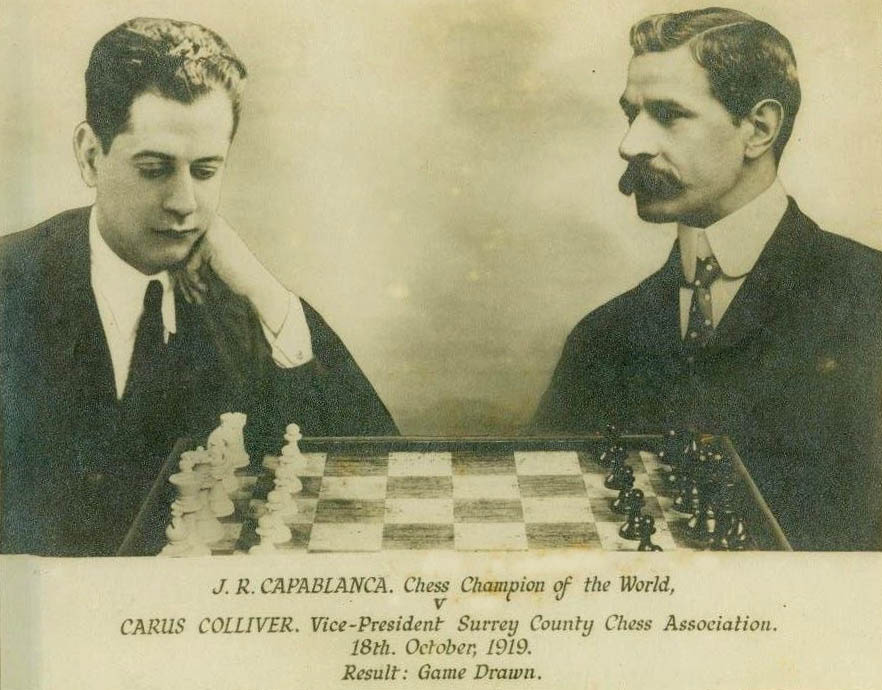
Having acquired this photograph recently, Eric Fisher (Hull, England) asks: ‘Do you have a record of Capablanca’s game with Carus Colliver, played on 18 October 1919?’
We have found no trace of the moves. The occasion was a simultaneous display by the Cuban (+ 35 –3 = 4) in Thornton Heath, England. Colliver (with the initial J.) was listed on page 5 of the Croydon Advertiser of 25 October 1919 as one of those who secured a draw. See also pages 123-125 of the 2/1999 Quarterly for Chess History.
Perhaps a reader could look into the records regarding Colliver’s tenure of the post of ‘Vice-President Surrey County Chess Association’. Capablanca, of course, was not yet ‘Chess Champion of the World’ in 1919, and his photograph in the montage looks to us like a 1922 shot. It is, in any case, the reverse form of a well-known picture to be found on, for instance, page 67 of Chess Strategy and Tactics by F. Reinfeld and I. Chernev (New York, 1933):
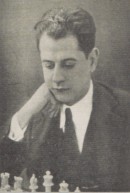
An augmented edition of our historical ‘address book’ is now available here. Thanks for contributions are expressed to Charles Milton Ling (Vienna), Russell Miller (Chelan, WA, USA) and Christian Sánchez (Rosario, Argentina).
Andy Ansel (Walnut Creek, CA, USA) informs us that he has a programme for Margate, 1938 signed not only by the players in the Premier Tournament but also by Madame Alekhine, who competed in Section A of the Second Class Tournament:
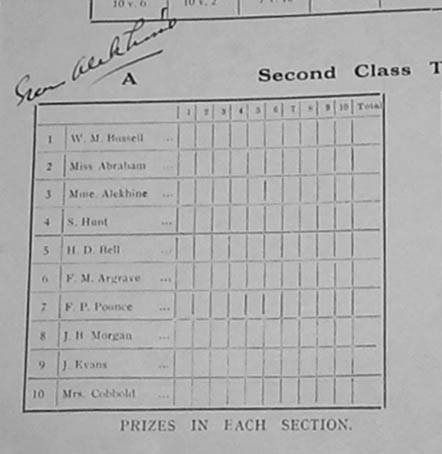
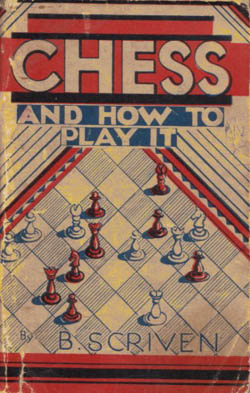
B. Scriven’s Chess and How to Play It, an egregious 1930s book which described the Anderssen-Kieseritzky Immortal Game as ‘a recent County Championship game’, was discussed on pages 269-270 of Kings, Commoners and Knaves and on page 295 of A Chess Omnibus. Since the book itself contained no publication date we adopted our preferred ‘safety first’ approach and merely wrote ‘late 1930s’ and, in the book lists, ‘circa 1939’. Now, though, our collection contains three editions of Scriven’s parvum opus, all slightly different in format, and the most recent acquisition has an owner’s inscription dated 5 January 1937. D.A. Betts’ Bibliography (page 108) gives the publication date as 1936, and the on-line catalogue of the chess library in The Hague refers to a reprint dated 1939. We do not know how those dates were determined, but they are altogether plausible.
Richard Forster (Winterthur, Switzerland) has found this cutting, from an unidentified journal:
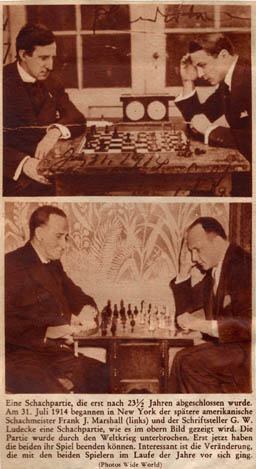
Below we add a further picture of Kurt Lüdecke with Adolf Hitler:
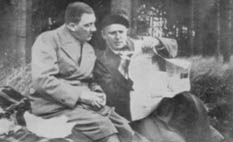
Gary Lane (Richmond, NSW, Australia) asks:
‘Should the opening sequence in the Nimzo-Indian 1 d4 Nf6 2 c4 e6 3 Nc3 Bb4 and now 4 e4 be known as the Dilworth Gambit?’
We believe that there are strong grounds for the name. Vernon Dilworth contributed an article on 4 e4 (entitled ‘A new move in the Niemtso-Indian Defence’) on pages 136, 137 and 156 of the March 1949 CHESS. He described 4 e3 ‘?’ as seeming ‘wantonly passive’ and suggested 4 e4 ‘!’ as preferable, with the continuation 4...Nxe4 5 Qg4 ‘!’. Some analysis was provided, much of it ‘based on trial games with the strong amateur A. Clegg’, and one such encounter was presented by Dilworth, enthusiastically annotated:
Vernon Dilworth – A. Clegg1 d4 Nf6 2 c4 e6 3 Nc3 Bb4 4 e4 Nxe4 5 Qg4 Nxc3 6 Bd2
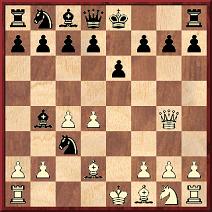
6...Nd5 7 cxd5 Bxd2+ 8 Kxd2 Qf6 9 Nf3 O-O 10 d6 cxd6 11 Bd3 Nc6 12 Rae1 b6 13 Re3 h6 14 h4 Bb7 15 Qe4 Qg6 16 Qf4 Qf6 17 Qxd6 Qe7 18 Qf4 Rac8 19 a3 f5 20 Rg1 Qf6 21 g4 fxg4 22 Qxg4 Ne7 23 Ne5 Rc7 24 Reg3 Qxf2+ 25 Kd1 Resigns. (‘An extremely interesting game, showing to advantage the attacking possibilities of the move 4 e4.’)
CHESS, however, sounded a note of caution:
‘Quite frankly, we doubt whether, in the fury of analysis which followed the introduction of the Niemtso-Indian Defence, 4 e4 failed to be examined. We fear this suggestion is more bold than sound.’
Readers were invited to refute the gambit, and on page 161 of the April 1949 CHESS a 15-year-old-reader from Manchester, I. Lanz, gave some analysis, beginning with 4...Nxe4 5 Qg4 Nxc3 6 Bd2 Nxa2 (a move not mentioned by Dilworth). On page 244 of the July, August and September 1949 CHESS the analytical debate was cut short:
‘We have received several more refutations of Mr Dilworth’s suggestion 4 e4, but have decided that the line really does not merit further discussion.’
After the original CHESS article appeared, the opening was scrutinized by C.J.S. Purdy on pages 134, 135, 136 and 144 of Chess World, 1 June 1949, under the title ‘Pipe-dream Chess’. Examining the above Dilworth v Clegg game in some depth and with some enmity, he wrote of 4 e4:
‘This is the new gambit. At first sight it looks like the only plausible losing move on the board, and that is how it still looks to us.’
After both 4...Nxe4 and 5...Nxc3 Purdy asked ‘why consider any other move?’, adding in the latter case:
‘Sometimes you can reason this way in chess: either this wins or I’m crazy, and if I’m crazy I won’t win anyway. It saves a lot of analysis.’
A number of Clegg’s moves were criticized, and especially 23...Rc7 (it being stated that 23...h5 would have at least drawn). Purdy also commented:
‘It is true that nobody has claimed that the gambit is sound. But the mere discussion of it as a worthwhile line for White is likely to warp the average student’s judgment. Hence the necessity for a counter-demonstration.
Granted, also, this gambit may succeed against very bad play. But any opening on earth will do that.
Some unsound opening variations in chess are well worthy of close study because there is only one way of refuting them. The one under discussion merely requires reasonable care and common sense.’
From page 59 of the March 1956 Chess World:
‘Although the BCM has never been guilty of sensation-mongering, in 1893 it carried one of the most startling items of chess news ever published. This was it:
“In the late terrible cholera epidemic at Hamburg, it is remarkable that no chessplayer of the large number living in that city and its suburbs was even attacked by the disease.”
Seeking for some rational cause that might at least partially explain this phenomenon, one remembers the late F.K. Esling’s comment that there was quite a big class of leisured people in Germany when he was there, and that most of the strong players belonged to it; they would presumably live in the less congested and insanitary areas. Esling visited Germany in the ’eighties, and ’93 was not much later.’
The BCM quote had appeared on page 25 of the January 1893 issue, i.e. shortly after publication of the following on page 349 of the November 1892 Deutsche Schachzeitung:
‘Im Hamburger Schachclub fand die Eröffnung der diesjährigen Spielsaison, welche sich in Folge der ungünstigen Zeitverhältnisse etwas verspätet hatte, am Dienstag den 18. October im neuen Locale im Patriotischen Gebäude statt. Der Vorsitzende leitete die Generalversammlung mit einigen Worten der Freude ein darüber, dass kein Mitglied des Vereins von der Cholera betroffen worden ...’
In short, a chess official merely reported that no member of the Hamburg association had caught cholera.
A prominent chessplayer who succumbed to cholera was Elijah Williams. To quote R.N. Coles on page 299 of the September 1954 BCM:
‘The summer of 1854 in London was overshadowed by a great epidemic of cholera, which out of a population of two-and-a-quarter million claimed over 3,000 deaths a week. The well-known chess master Elijah Williams, himself a doctor, was actually playing in the Divan one day in September when the disease attacked him ...’
It may be mentioned in passing that the entry on Williams in Harry Golombek’s Encyclopedia of Chess (London, 1977 and Harmondsworth, 1981) duly recorded that he died in 1854 but carelessly suggested that he was still writing his chess column in The Field three years later.
In the chapter ‘Ahead of Their Time’ in The Chess Companion (New York, 1968) Irving Chernev declared himself intrigued by Williams’ performance at London, 1851. From page 184:
‘Was his prolonged thinking part of a plan to infuriate his opponents? Or was it because he was slowly evolving a new system of play?
The terms “Double Pawn Complex” and “Zugzwang” could have had no meaning for Williams, but here, in two games [against Löwenthal and Staunton], we have this Nimzowitsch of a hundred years ago demonstrating these concepts.’
Chernev’s item originally appeared as an article on page 340 of the November 1955 Chess Review. We wonder if other writers have attempted to back up his theory, although nothing particularly helpful has yet been found by us in Williams’ book Horæ Divanianæ (London, 1852) or in other sources.
Michael McDowell (Westcliff-on-sea, England) has sent us a
number of problems composed by over-the-board masters, and the
series begins here with this composition by Frank J. Marshall (Our
Folder, February 1917):
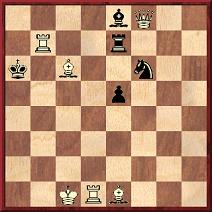
Mate in two.
Our correspondent observes:
‘A neat rendering of a familiar idea. Marshall had clearly learned something about composing technique since making the trivial problem below, which was quoted on page 236 of the Chess Amateur, May 1914.’
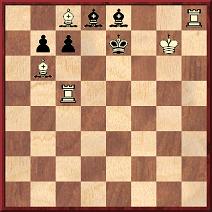
Mate in two.
On page 2 of volume two of Chess Characters (Geneva, 1987) G.H. Diggle (referring to himself in the third person as the ‘BM’, i.e. the Badmaster) wrote about J.M. Aitken, who had been Scottish champion ten times:
‘... he has very pleasant memories of Dr Aitken, whom he once actually had to meet in the very first round of a Tournament, and felt like a rabbit facing a python. After “it was all over” the Doctor, conducting the inquest, never once expatiated on “where Black had gone wrong”, but shook his head over his own play, which at one point had been “terribly speculative”. Apart from his play, the Doctor (in the opinion of the BM) was one of the best chess book reviewers in the World.’
The tournament in question was London, 1945 (won by G. Wood ahead of P.M. List). The photograph below shows Aitken (left) in play against Diggle, with Sir George Thomas and G. Wood behind them:
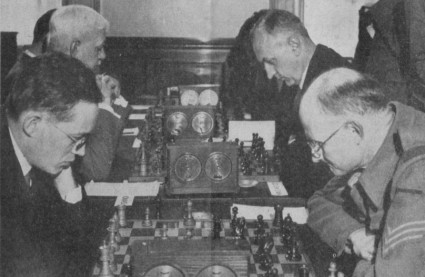
When commenting in C.N. 3606 that Brian Reilly was perhaps the best of all the BCM editors, we had in mind not just his own writing but his skill in assembling, and maintaining over the decades, some outstanding contributors. There were, for instance, frequent book reviews by not only J.M. Aitken but also W.H. Cozens, W. Heidenfeld, D.J. Morgan and, indeed, G.H. Diggle himself.
Aitken had fine judgement and was not averse to using a ‘sophisticated’ word or Shakespearean quote to underscore his point, as shown by this extract from his review of the ninth edition of Modern Chess Openings (in the January 1958 BCM, pages 15-16):
‘The task of compilers of opening guides (at least on the scale of MCO) is nowadays sisyphean. It is never “done when ’tis done”; rather when published it is already beginning to be undone.’
And here is his novel start to a discussion of two books on, respectively, attacking and defensive lines in the Sicilian Defence, in the BCM, March 1976, pages 114-116:
‘In the days of the battleship there was an eternal struggle between the inventors of more armour-piercing shells and the designers of more shell-resistant armour; a similar pattern can sometimes be discerned in the theoretic struggle of the chess opening. These two books illustrate this perfectly.’
Aitken was an intellectual and a scholar, in the best sense of both terms, and with considerable admiration we have been reading his historical volume The Trial of George Buchanan Before The Lisbon Inquisition (Edinburgh and London, 1939).
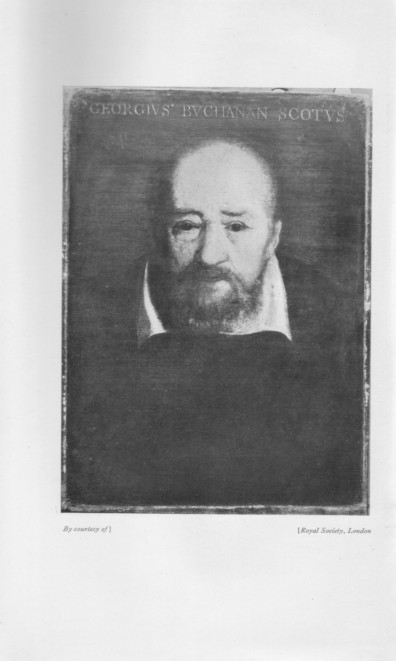
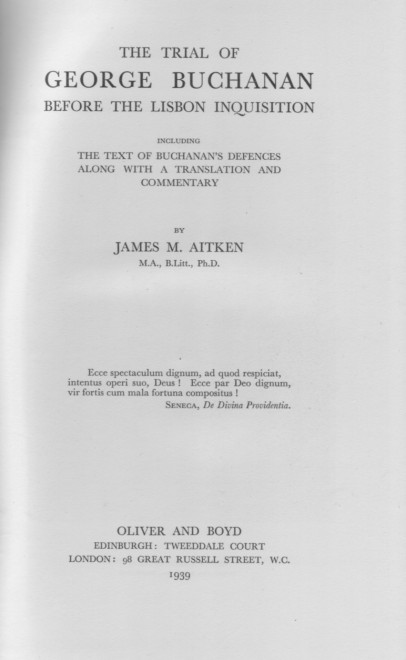
Aitken’s Preface (page viii) explained that the original text was ‘written as a Ph.D. thesis, and was accepted as such by Edinburgh University in December 1938’. His erudition was remarkable, and it is a pity that he never authored a full-scale chess book.
In a wide-ranging letter about books on pages 58-59 of the December 1950 CHESS A.C. Simonson wrote:
‘I like to find instances where the annotators make mistakes. The armchair critics, as I like to term them, are always looking to criticize the players; in doing so, they very often make laughable mistakes themselves.’
And:
‘Incidentally, although I have discovered such errors in every single chess book, the prize seems to be captured by H. Golombek with his Capablanca’s Hundred Best Games, which contains – literally – hundreds of typographical, diagrammatic and annotation errors.’
On page 81 of the January 1951 issue Golombek made one of his rare contributions to CHESS:
‘... I should like to point out that this is quite untrue with regards to the English edition. To the best of my knowledge it contains only one misprint which, I think you will agree is well below the average for a book of its size and type.
However, it is true that the American edition contains many errors. This was due to the fact that the American publishers, by a stupid blunder on their part, failed to incorporate my galley proof corrections in the final proofs they sent to the printers. This was a circumstance over which neither my English publishers nor myself had any control as we were in no way responsible for the American printing.’
The CHESS editor was unconvinced:
‘Mr Simonson gave some random examples of the errors and, whilst the misprints are admittedly almost absent from the English edition, his analytical criticisms do apply to it, seem well based and, for the first few games alone, with diagrams would fill a page of CHESS.’
As regards Golombek’s recognition of only one misprint in the English edition of his book, it may be recalled that in C.N. 3586 we provided an eight-page list of mistakes of all kinds. It would certainly have been far longer had it dealt with the US edition.
In the context of the controversy over whether Reshevsky wrote the annotations in Reshevsky on Chess C.N. 2039 (see page 322 of Kings, Commoners and Knaves) quoted briefly from what we termed ‘a fulminatory letter from Reinfeld to E.G.R. Cordingley’ on page 121 of CHESS, March 1952. It is high time we gave the full CHESS item, which appeared under the headline ‘Explosion!’:
‘E.G.R. Cordingley has allowed disparagement of others to become almost an obsession. A recent article of his sneered, in the course of a few paragraphs, at “the flaccid and superficial reviews appearing in other magazines”, their critics’ “small knowledge of the polyglot literature of the game” and “easy acceptance of a mediocre standard”, went on to mention the “ignorance” of chess publishers and accused magazines of dishonest reviewing so as not to harm sales.
All this was introductory to quoting a letter from Fred Reinfeld to him as follows, which shows how such a critic can get under an author’s skin:
“Dear Sir: ... For years, as I have been reading your boorish, spiteful and peevish slanders of my work, I have wondered where you acquired the right to pontificate in this Draconian manner. Is it from your masterly showing in the Surrey Championship; from your trashy little volume which is the only one you ever succeeded in getting published; is it from the scrawny magazine and tournament ‘books’ cluttered up with misprints and illegible spots?
Although you have consistently maligned my work, you praised the ‘Reshevsky’ annotations to the skies; would you have done so if you had known that I wrote those annotations?
Please do not bother to communicate with me, for reasons of explanations or otherwise. I am thoroughly disgusted with being the subject of the ravings of an ignoramus. – Fred Reinfeld.”
In his fury, Fred Reinfeld has rather let the cat out of the bag. Certainly Cordingley’s review of Reshevsky on Chess was exceptionally fulsome for him.’
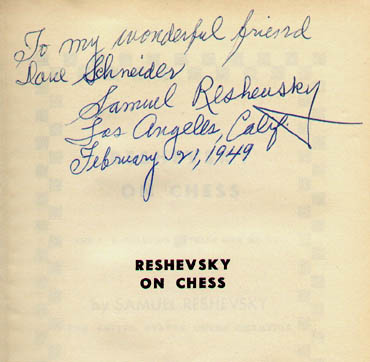
The first sentence of an article by C.J.S. Purdy on page 250 of Chess World, November 1956:
‘If asked what I found the most useful principle of chess I should unhesitatingly reply: Reserve the greater option.’
Calle Erlandsson (Lund, Sweden) informs us that during a recent visit to the Stockholm Chess Union he took photographs of two works of art on its premises.
‘The first is a huge painting (about 5m x 2m) of 33 chessplayers by the Finnish artist Antti Favén (1882-1948). It was owned by the late Erik Lundin and was donated to the Union. The 33 players are more or less well known, with Siegbert Tarrasch in the background. Perhaps C.N. readers can identify the others.
The second work is a portrait of Alexander Alekhine by Gabriel Strandberg (1885-1966), donated to the Union by Uno Hedin on 2 September 1997.’
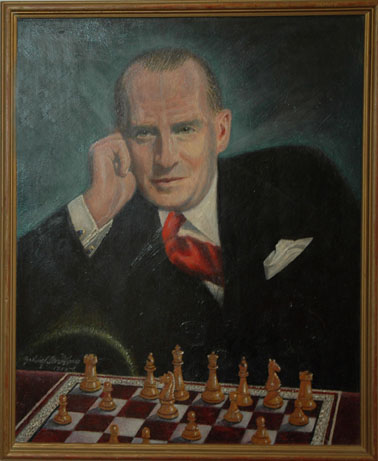
We note that this is based on the photograph of Alekhine which was, for instance, the frontispiece to the first (1939) edition of My Best Games of Chess 1924-1937:
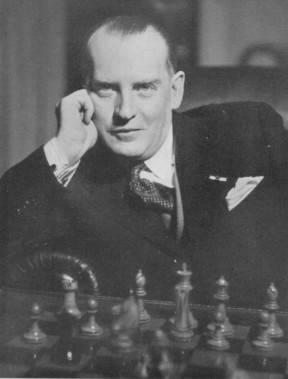
V. Ragozin claimed that it was advantageous to have Black rather than White – or did he? We have frequently stressed the need for quotes and other information to be accompanied by precise sources, since the reader is entitled to know the provenance of all material presented. As an example of the kind of misunderstanding which may otherwise occur, here are some remarks by Almeida Soares of Brazil on page 56 of CHESS, December 1949:
‘It is ingrained in us that the Whites, playing first, have an advantage. It was no small surprise to me therefore when I read an article in the magazine Le Monde des Echecs by V. Ragozin, the master who trained Botvinnik, the world’s champion, asserting that the advantage of the opening move lies with the player of the black pieces.’
Anyone wishing to verify this matter is fortunate that Soares at least provided what might be termed a ‘semi-source’ and that the French magazine named, though not dated, by him ran for less than a year. There is thus no difficulty in tracing the article in question: ‘La défaite des joueurs d’échecs anglais’ on pages 228-229 of the July-August 1946 issue. But this reveals that Ragozin wrote something altogether different:
‘Les joueurs contemporains estiment que la victoire la plus honorable est celle remportée en jouant avec les Noirs.’ [‘Contemporary players consider that the most honorable victories are those achieved with Black.’]
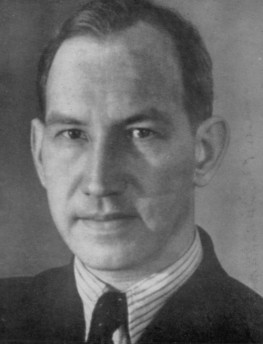
Viacheslav Ragozin
Some terse exchanges during a chess game:
White: ‘Helm knight.’
Black: ‘Kraal.’
White: ‘Munster.’
Black: ‘Minstrel.’
Umpire: ‘Machine.’
What does this mean?
Chess Notes Archives:
| First column | << previous | Archives [10] | next >> | Current column |
Copyright 2005 Edward Winter. All rights reserved.